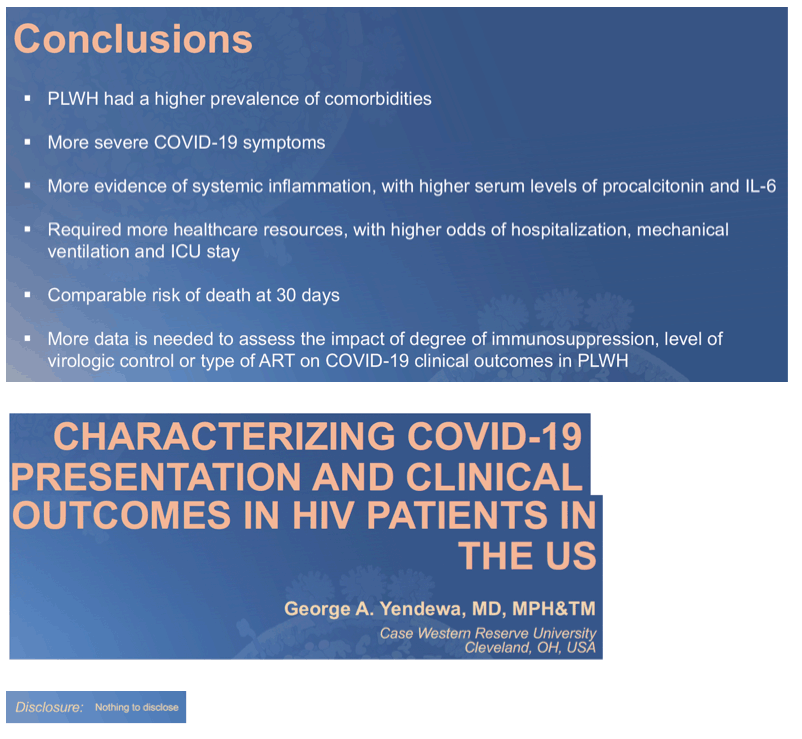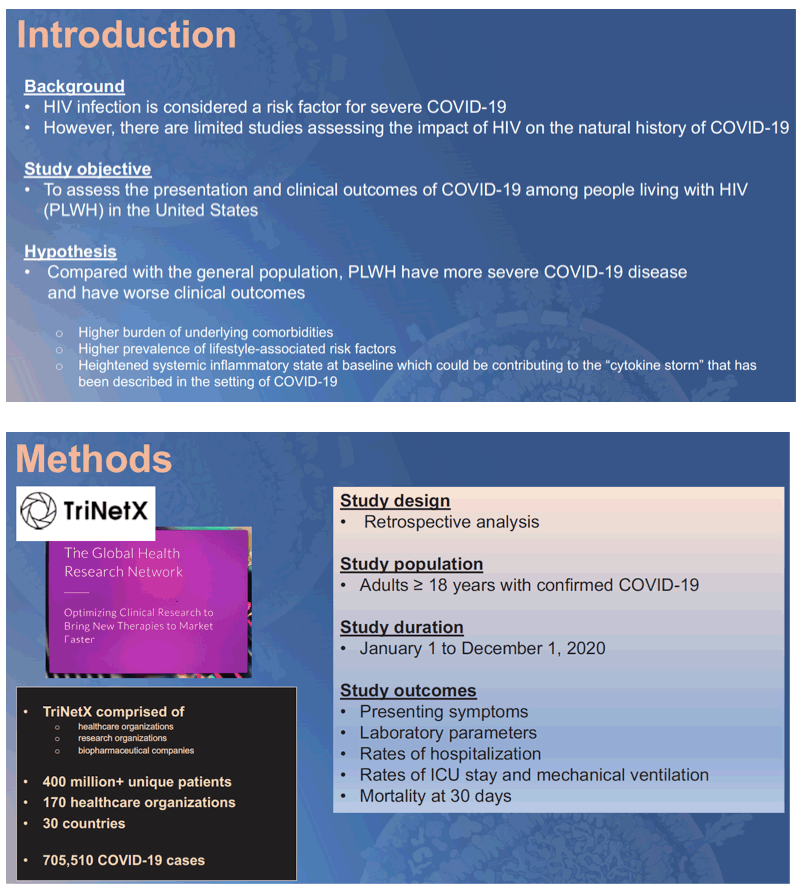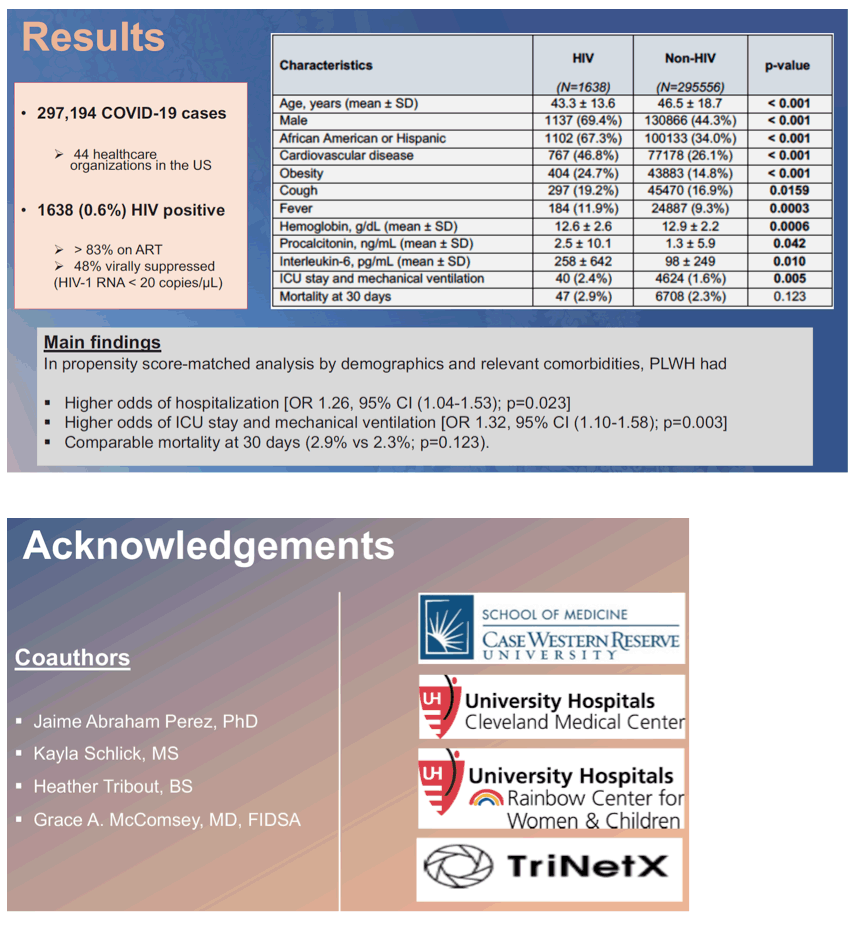 |
 |
 |
| |
CHARACTERIZING COVID-19 PRESENTATION AND CLINICAL OUTCOMES IN HIV PATIENTS IN THE US
|
| |
| |
CROI: COVID-19 HOSPITALIZATION AMONG PEOPLE WITH HIV OR SOLID ORGAN TRANSPLANT IN THE US - (03/09/21)
CROI: HIV AND COVID-19 INPATIENT OUTCOMES: A MATCHED RETROSPECTIVE MULTICENTRE ANALYSIS - (03/09/21)
CROI: In-Hospital COVID-19 Outcomes Not Worse With HIV in 6-Center UK Analysis - (03/09/21)
CROI 2021 March 6-10 Reported by Jules Levin
George A . Yendewa, Jaime A. Perez, Kayla A. Schlick2, Heather A. Tribout2, Grace A. McComsey1
1CaseWesternReserveUniversity,Cleveland,OH,USA, 2University Hospitals Cleveland Medical Center, Cleveland, OH, USA
Background: HIV infection is considered a risk factor for severe SARS-CoV-2 (COVID-19) infection; however, there are limited studies assessing the impact of HIV on COVID-19 presentation and clinical outcomes.
Methods: We used TriNetX (a large global health research network) to compare adult HIV and non-HIV patients with confirmed SARS-CoV-2 infection who sought care across 44 healthcare facilities in the US January to December 2020. We assessed demographic characteristics, comorbidities, presenting symptoms, laboratory parameters, rate of hospitalization, rate of intensive care service utilization requiring mechanical ventilation and mortality at 30 days after diagnosis. Continuous data were compared using independent t-tests and categorical data were compared using Chi-square or Fishers exact test, as appropriate. Potential confounders were addressed using 1:1 greedy nearest-neighbor propensity score matching based on demographics and key comorbidities. For outcomes of interest, we calculated odds ratios (OR) and 95% confidence intervals (CI), with p < 0.05 considered statistically significant in all analyses.
Results: Of 297194 confirmed COVID-19 cases, 1638 (0.6%) were HIV-infected, with > 83% on antiretroviral therapy (ART) and 48% virally suppressed (HIV-1 RNA < 20 copies/μL). Compared with their non-HIV counterparts, HIV patients were more commonly younger (p < 0.001), male (p < 0.001), African American or Hispanic (p < 0.001), had more cardiovascular disease (p < 0.001) and other comorbidities, were more symptomatic at presentation and had higher utilization of all healthcare services (Table 1). On laboratory parameters, HIV patients were more anemic (p < 0.001), thrombocytopenic (p < 0.001) and had elevated serum creatinine (p < 0.001), procalcitonin (p=0.042) and interleukin-6 (p=0.010) levels. In propensity score-matched analysis by demographics and relevant comorbidities, HIV patients had significantly higher odds of hospitalization [OR 1.26, 95% CI (1.04-1.53); p=0.023] and severe illness requiring intensive care stay and mechanical ventilation [OR 1.32, 95% CI (1.10- 1.58); p=0.003]. Mortality at 30 days was higher among HIV patients but did not attain statistical significance (2.9% vs 2.3%; p=0.123).
Conclusion: In one the largest studies to date, HIV patients had more underlying risk factors, symptom severity and higher odds of hospitalization and mechanical ventilation but were not significantly more at risk of death at 30 days after COVID-19 diagnosis compared to non-HIV controls.



|
| |
|
 |
 |
|
|